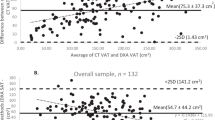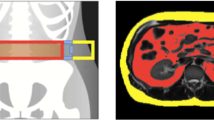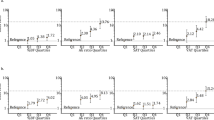Abstract
Purpose:
Cross-sectional imaging may enable accurate localization and quantification of subcutaneous and visceral adipose tissue. The reproducibility of multi-detector computed tomography (MDCT)-based volumetric quantification of abdominal adipose tissue and the ability to depict age- and gender-related characteristics of adipose tissue deposition have not been reported.
Methods:
We evaluated a random subset of 100 Caucasian subjects (age range: 37–83 years; 49% women) of the Framingham Heart Study offspring cohort who underwent MDCT scanning. Two readers measured subcutaneous and visceral adipose tissue volumes (SAV and VAV; cm3) and areas (SAA and VAA; cm2) as well as abdominal sagital diameter (SD) and waist circumference (WC).
Results:
Inter-reader reproducibility was excellent (relative difference: −0.34±0.52% for SAV and 0.59±0.93% for VAV, intra-class correlation (ICC)=0.99 each). The mean SAA/VAA ratio was significantly different from the mean SAV/VAV ratio (2.0±1.2 vs 1.7±0.9; P<0.001). The ratio of SAV/VAV was only weakly inversely associated with SD (ICC=−0.32, P=0.01) and not significantly associated with WC (ICC=−0.14, P=0.14) or body mass index (ICC=−0.17, P=0.09). The mean SAV/VAV ratio was significantly different between participants <60 vs >60 years (1.9±1.0 vs 1.5±0.7; P<0.001) and between men and women (1.2±0.5 vs 2.2±0.9; P<0.001).
Conclusion:
This study demonstrates that MDCT-based volumetric quantification of abdominal adipose tissue is highly reproducible. In addition, our results suggest that volumetric measurements can depict age- and gender-related differences of visceral and subcutaneous abdominal adipose tissue deposition. Further research is warranted to assess whether volumetric measurements may substantially improve the predictive value of obesity measures for insulin resistance, type 2 diabetes mellitus and other diseases.
This is a preview of subscription content, access via your institution
Access options
Subscribe to this journal
Receive 12 print issues and online access
$259.00 per year
only $21.58 per issue
Buy this article
- Purchase on Springer Link
- Instant access to full article PDF
Prices may be subject to local taxes which are calculated during checkout



Similar content being viewed by others
References
WHO. Physical status: the use and interpretation of anthropometry. Report of a WHO Expert Committee. World Health Organ Tech Rep Ser 1995; 854: 1–452.
Rosenbaum M, Leibel RL, Hirsch J . Obesity. N Engl J Med 1997; 337: 396–407.
Lapidus L, Bengtsson C, Larsson B, Pennert K, Rybo E, Sjostrom L . Distribution of adipose tissue and risk of cardiovascular disease and death: a 12 year follow up of participants in the population study of women in Gothenburg, Sweden. Br Med J (Clin Res Ed) 1984; 289: 1257–1261.
Peiris AN, Sothmann MS, Hoffmann RG, Hennes MI, Wilson CR, Gustafson AB et al. Adiposity, fat distribution, and cardiovascular risk. Ann Intern Med 1989; 110: 867–872.
Kopelman PG . Obesity as a medical problem. Nature 2000; 404: 635.
Hubert HB, Feinleib M, McNamara PM, Castelli WP . Obesity as an independent risk factor for cardiovascular disease: a 26-year follow-up of participants in the Framingham Heart Study. Circulation 1983; 67: 968–977.
Larsson B, Svardsudd K, Welin L, Wilhelmsen L, Bjorntorp P, Tibblin G . Abdominal adipose tissue distribution, obesity, and risk of cardiovascular disease and death: 13 year follow up of participants in the study of men born in 1913. Br Med J (Clin Res Ed) 1984; 288: 1401–1404.
Jonsson S, Hedblad B, Engstrom G, Nilsson P, Berglund G, Janzon L . Influence of obesity on cardiovascular risk. Twenty-three-year follow-up of 22 025 men from an urban Swedish population. Int J Obes Relat Metab Disord 2002; 26: 1046–1053.
Anjana M, Sandeep S, Deepa R, Vimaleswaran KS, Farooq S, Mohan V . Visceral and central abdominal fat and anthropometry in relation to diabetes in Asian Indians. Diabetes Care 2004; 27: 2948–2953.
Matsuzawa Y . Adipocytokines and metabolic syndrome. Semin Vasc Med 2005; 5: 34–39.
Hotamisligil GS, Shargill NS, Spiegelman BM . Adipose expression of tumor necrosis factor-alpha: direct role in obesity-linked insulin resistance. Science 1993; 259: 87–91.
Matsuzawa Y . Adiponectin: identification, physiology and clinical relevance in metabolic and vascular disease. Atheroscler Suppl 2005; 6: 7–14.
Shimomura I, Funahashi T, Takahashi M, Maeda K, Kotani K, Nakamura T et al. Enhanced expression of PAI-1 in visceral fat: possible contributor to vascular disease in obesity. Nat Med 1996; 2: 800–803.
Steppan CM, Bailey ST, Bhat S, Brown EJ, Banerjee RR, Wright CM et al. The hormone resistin links obesity to diabetes. Nature 2001; 409: 307–312.
Hug C, Lodish HF . Medicine. Visfatin: a new adipokine. Science 2005; 307: 366–367.
Wannamethee SG, Shaper AG, Morris RW, Whincup PH . Measures of adiposity in the identification of metabolic abnormalities in elderly men. Am J Clin Nutr 2005; 81: 1313–1321.
Seidell JC, Cigolini M, Charzewska J, Ellsinger BM, Deslypere JP, Cruz A . Fat distribution in European men: a comparison of anthropometric measurements in relation to cardiovascular risk factors. Int J Obes Relat Metab Disord 1992; 16: 17–22.
Ledoux M, Lambert J, Reeder BA, Despres JP . Correlation between cardiovascular disease risk factors and simple anthropometric measures. Canadian Heart Health Surveys Research Group. Can Med Assoc J 1997; 157 (Suppl 1): S46–S53.
Dobbelsteyn CJ, Joffres MR, MacLean DR, Flowerdew G . A comparative evaluation of waist circumference, waist-to-hip ratio and body mass index as indicators of cardiovascular risk factors. The Canadian Heart Health Surveys. Int J Obes Relat Metab Disord 2001; 25: 652–661.
Rexrode KM, Buring JE, Manson JE . Abdominal and total adiposity and risk of coronary heart disease in men. Int J Obes Relat Metab Disord 2001; 25: 1047–1056.
Molarius A, Seidell JC . Selection of anthropometric indicators for classification of abdominal fatness – a critical review. Int J Obes Relat Metab Disord 1998; 22: 719–727.
Sjostrom L, Kvist H, Cederblad A, Tylen U . Determination of total adipose tissue and body fat in women by computed tomography, 40K, and tritium. Am J Physiol 1986; 250: E736–E745.
Borkan GA, Gerzof SG, Robbins AH, Hults DE, Silbert CK, Silbert JE . Assessment of abdominal fat content by computed tomography. Am J Clin Nutr 1982; 36: 172–177.
Yoshizumi T, Nakamura T, Yamane M, Islam AH, Menju M, Yamasaki K et al. Abdominal fat: standardized technique for measurement at CT. Radiology 1999; 211: 283–286.
Kvist H, Chowdhury B, Sjostrom L, Tylen U, Cederblad A . Adipose tissue volume determination in males by computed tomography and 40K. Int J Obes 1988; 12: 249–266.
Shrout P, Fleiss J . Intraclass correlations: uses in assessing rater reliability. Psychol Bull 1979; 86: 420–428.
Cnop M, Landchild MJ, Vidal J, Havel PJ, Knowles NG, Carr DR et al. The concurrent accumulation of intra-abdominal and subcutaneous fat explains the association between insulin resistance and plasma leptin concentrations: distinct metabolic effects of two fat compartments. Diabetes 2002; 51: 1005–1015.
Goodpaster BH, Krishnaswami S, Harris TB, Katsiaras A, Kritchevsky SB, Simonsick EM et al. Obesity, regional body fat distribution, and the metabolic syndrome in older men and women. Arch Intern Med 2005; 165: 777–783.
von Eyben FE, Mouritsen E, Holm J, Montvilas P, Dimcevski G, Suciu G et al. Intra-abdominal obesity and metabolic risk factors: a study of young adults. Int J Obes Relat Metab Disord 2003; 27: 941–949.
Kobayashi J, Tadokoro N, Watanabe M, Shinomiya M . A novel method of measuring intra-abdominal fat volume using helical computed tomography. Int J Obes Relat Metab Disord 2002; 26: 398–402.
Piche ME, Weisnagel SJ, Corneau L, Nadeau A, Bergeron J, Lemieux S . Contribution of abdominal visceral obesity and insulin resistance to the cardiovascular risk profile of postmenopausal women. Diabetes 2005; 54: 770–777.
Onat A, Avci GS, Barlan MM, Uyarel H, Uzunlar B, Sansoy V . Measures of abdominal obesity assessed for visceral adiposity and relation to coronary risk. Int J Obes Relat Metab Disord 2004; 28: 1018–1025.
Albu JB, Kovera AJ, Allen L, Wainwright M, Berk E, Raja-Khan N et al. Independent association of insulin resistance with larger amounts of intermuscular adipose tissue and a greater acute insulin response to glucose in African American than in white nondiabetic women. Am J Clin Nutr 2005; 82: 1210–1217.
Gallagher D, Kuznia P, Heshka S, Albu J, Heymsfield SB, Goodpaster B et al. Adipose tissue in muscle: a novel depot similar in size to visceral adipose tissue. Am J Clin Nutr 2005; 81: 903–910.
Baumgartner RN, Heymsfield SB, Roche AF . Human body composition and the epidemiology of chronic disease. Obes Res 1995; 3: 73–95.
Seidell JC, Visscher TL . Body weight and weight change and their health implications for the elderly. Eur J Clin Nutr 2000; 54 (Suppl 3): S33–S39.
Thomas EL, Bell JD . Influence of undersampling on magnetic resonance imaging measurements of intra-abdominal adipose tissue. Int J Obes Relat Metab Disord 2003; 27: 211–218.
Greenfield JR, Samaras K, Chisholm DJ, Campbell LV . Regional intra-subject variability in abdominal adiposity limits usefulness of computed tomography. Obes Res 2002; 10: 260–265.
Lemieux S, Prud'homme D, Bouchard C, Tremblay A, Despres JP . Sex differences in the relation of visceral adipose tissue accumulation to total body fatness. Am J Clin Nutr 1993; 58: 463–467.
Ross R, Leger L, Morris D, de Guise J, Guardo R . Quantification of adipose tissue by MRI: relationship with anthropometric variables. J Appl Physiol 1992; 72: 787–795.
Machann J, Thamer C, Schnoedt B, Haap M, Haring HU, Claussen CD et al. Standardized assessment of whole body adipose tissue topography by MRI. J Magn Reson Imaging 2005; 21: 455–462.
Chowdhury B, Sjostrom L, Alpsten M, Kostanty J, Kvist H, Lofgren R . A multicompartment body composition technique based on computerized tomography. Int J Obes Relat Metab Disord 1994; 18: 219–234.
Positano V, Gastaldelli A, Sironi AM, Santarelli MF, Lombardi M, Landini L . An accurate and robust method for unsupervised assessment of abdominal fat by MRI. J Magn Reson Imaging 2004; 20: 684–689.
Wilhelm Poll L, Wittsack HJ, Koch JA, Willers R, Cohnen M, Kapitza C et al. A rapid and reliable semiautomated method for measurement of total abdominal fat volumes using magnetic resonance imaging. Magn Reson Imaging 2003; 21: 631–636.
Sobol W, Rossner S, Hinson B, Hiltbrandt E, Karstaedt N, Santago P et al. Evaluation of a new magnetic resonance imaging method for quantitating adipose tissue areas. Int J Obes Relat Metab Disord 1991; 15: 589–599.
Seidell JC, Bakker CJ, van der Kooy K . Imaging techniques for measuring adipose-tissue distribution – a comparison between computed tomography and 1.5-T magnetic resonance. Am J Clin Nutr 1990; 51: 953–957.
Acknowledgements
The Framingham Heart Study is supported by the National Heart, Lung and Blood Institute (N01-HC-25195).
Author information
Authors and Affiliations
Corresponding author
Rights and permissions
About this article
Cite this article
Maurovich-Horvat, P., Massaro, J., Fox, C. et al. Comparison of anthropometric, area- and volume-based assessment of abdominal subcutaneous and visceral adipose tissue volumes using multi-detector computed tomography. Int J Obes 31, 500–506 (2007). https://doi.org/10.1038/sj.ijo.0803454
Received:
Revised:
Accepted:
Published:
Issue Date:
DOI: https://doi.org/10.1038/sj.ijo.0803454
Keywords
This article is cited by
-
Evaluation of Mucosal Healing in Crohn’s Disease: Radiomics Models of Intestinal Wall and Mesenteric Fat Based on Dual-Energy CT
Journal of Imaging Informatics in Medicine (2024)
-
Anthropometric estimators of abdominal fat volume in adults with overweight and obesity
International Journal of Obesity (2023)
-
CT-based measurement of visceral adipose tissue volume as a reliable tool for assessing metabolic risk factors in prediabetes across subtypes
Scientific Reports (2023)
-
Association of pericoronary adipose tissue with atrial fibrillation recurrence after ablation based on computed tomographic angiography
Japanese Journal of Radiology (2023)
-
Relationship of computed tomography quantified visceral adiposity with the severity and complications of acute pancreatitis: a systematic review
Japanese Journal of Radiology (2023)



